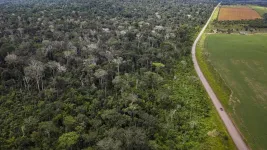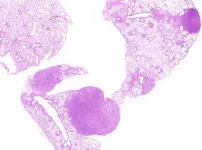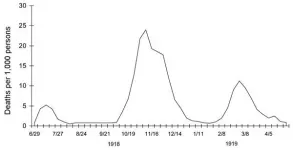INFORMATION:
The findings are outlined in the paper 'Tracking the impacts of El Niño drought and fire in human-modified Amazonian forests', which has been published by PNAS (Proceedings of the National Academy of Sciences of the United States of America).
The research was supported by the Natural Environment Research Council (NERC), part of UKRI, and the Brazilian National Council for Scientific and Technological Development (CNPq) in Brazil.
The paper's authors are: Erika Berenguer of Lancaster University and the University of Oxford; Gareth Lennox, Filipe Franca, Charlotte Smith and Kieran Withey of Lancaster University; Jos Barlow of Lancaster University and the Universidade Federal de Lavras; Yadvinder Malhi of the University of Oxford; Luiz Aragão of the National Institute for Space Research (Brazil) and the University of Exeter; Julia Barreto of Universidade de São Paulo; Fernando Espírito-Santo of the University of Leicester and Universidade de São Paulo; Axa Figueredo and Carlos Quesada of the National Institute for Amazonian Research; Toby Gardner of the Stockholm Environment Institute; Carlos Joly of the Universidade Estadual de Campinas; Alessandro Palmeira of the Universidade Federal do Pará and the National Institute for Space Research; Liana Chesini Rossi of the Universidade Estadual Paulista; Marina Moraes de Seixas of the Embrapa Amazônia Oriental; and Joice Ferreira from Embrapa.
Flyover video: END
Epicentre of major Amazon droughts and fires saw 2.5 billion trees and vines killed
A major drought and forest fires in the Amazon rainforest killed billions of trees and plants and turned one of the world's largest carbon sinks into one of its biggest polluters.
2021-07-19
(Press-News.org) A major drought and forest fires in the Amazon rainforest killed billions of trees and plants and turned one of the world's largest carbon sinks into one of its biggest polluters.
Triggered by the 2015-16 El Niño, extreme drought and associated mega-wildfires caused the death of around 2.5 billion trees and plants and emitted 495 million tonnes of CO2 from an area that makes up just 1.2 per cent of the entire Brazilian Amazon rainforest, and 1 per cent of the whole biome.
The stark findings, discovered by an international team of scientists working for more than eight years on a long-term study in the Amazon before, during and after the El Niño, have significant implications for global efforts to control the atmospheric carbon balance.
In normal circumstances, because of high moisture levels, the Amazon rainforest does not burn. However, extreme drought makes the forest temporarily flammable. Fires started by farmers can escape their land and trigger forest fires.
According to climate predictions, extreme droughts will become more common and, until now, the long-term effects of drought and fires on the Amazon rainforest, and particularly within forests disturbed by people through activities such as selective or illegal logging, were largely unknown.
Examining the Amazonian epicentre of the El Niño - Brazil's Lower Tapajós, an eastern Amazonia area around twice the size of Belgium - the research team, led by scientists from Lancaster University, the University of Oxford, and The Brazilian Agricultural Research Corporation found the damage lasts for multiple years.
The study revealed that trees and plants in drought-affected forests, as well as burned forests, continued to die at a rate above the norm for up to three years after the El Niño drought - releasing more CO2.into the atmosphere.
The total carbon emissions from the drought and fires in the Lower Tapajós region alone were higher than a whole year's deforestation within the entire Amazon. And, as a result of the drought and fires, the region released as much over a three-year period as some of the world's worst polluting countries' yearly carbon emissions - exceeding the emissions of developed countries such as the UK and Australia.
After three years, only around a third (37%) of the emissions were re-absorbed by plant growth in the forest. This shows that the Amazon's vital function as a carbon sink can be hampered for years following these drought events.
Dr Erika Berenguer, lead author of the report from Lancaster University and the University of Oxford, said: "Our results highlight the enormously damaging and long-lasting effects fires can cause in Amazonian forests, an ecosystem that did not co-evolve with fires as a regular pressure."
The scientists gathered data by regularly revisiting 21 plots across a mixture of primary forest, secondary re-growing forest and forests where people have selectively logged. The results from these plots were then extrapolated to the region.
Although previous research has shown human-disturbed forests are more susceptible to fires, it was unknown if there was any difference in the vulnerability and resilience of trees and plants in these forests when drought and fires happen.
The study showed that while many trees died in primary forest affected by drought, the loss of trees was much worse in secondary and other human-disturbed forests. The researchers found that trees and plants with lower wood density and thinner barks were more prone to dying from the drought and fires. These smaller trees are more common in human-disturbed forests.
The researchers estimate that around 447 million large trees (greater than 10cm Diameter at Breast Height) died, and around 2.5 billion smaller trees (less than 10cm DBH) died across the Lower Tapajós region.
The researchers also compared the effect on different forest types from drought alone, as well as the combined stresses of drought and fire.
Tree and plant mortality was higher in secondary forests from drought alone when compared with primary forests. Impact from drought was not higher in human-modified forests, but was significantly greater in those human-modified forests that experienced a combination of drought and fire.
Carbon emissions from those forests burned by wildfires were almost six times higher than forests affected by drought alone.
These findings highlight how interference by people can make the Amazon forests more vulnerable and underline the need to reduce illegal logging and other large-scale human disturbances of forests in the Amazon, as well as investments in fire-fighting capabilities in the Amazon.
Professor Jos Barlow of Lancaster University and the Universidade Federal de Lavras, and Principal Investigator of the research, said: "The results highlight the need for action across different scales. Internationally, we need action to tackle climate change, which is making extreme droughts and fires more likely. At the local level, forests will suffer fewer negative consequences from fires if they are protected from degradation."
ELSE PRESS RELEASES FROM THIS DATE:
Stanford researchers use high-speed cameras to reveal bubbles popping like blooming flowers
2021-07-19
The oil industry, pharmaceutical companies and bioreactor manufacturers all face one common enemy: bubbles. Bubbles can form during the manufacturing or transport of various liquids, and their formation and rupture can cause significant issues in product quality.
Inspired by these issues and the puzzling physics behind bubbles, an international scientific collaboration was born. Stanford University chemical engineer Gerald Fuller along with his PhD students Aadithya Kannan and Vinny Chandran Suja, as well as visiting PhD student Daniele Tammaro from the University of Naples, teamed up to study how different kinds of bubbles pop.
The researchers were particularly interested in bubbles with proteins embedded on their surfaces, which is a common occurrence in the pharmaceutical industry ...
Seismic surveys have no significant impact on commercially valuable fish in NW Australia
2021-07-19
New research has found marine seismic surveys used in oil and gas exploration are not impacting the abundance or behaviour of commercially valuable fishes in the tropical shelf environment in north-western Australia.
The research is the first of its kind to use dedicated seismic vessels to measure the impacts of the survey's noise in an ocean environment, with the eight-month experiment conducted within a 2500 square kilometre fishery management zone near the Pilbara coast.
It involved using multiple acoustic sensors, tagging 387 red emperor fish and deploying more than ...
CNIO researchers clarify the role of the two isoforms of KRAS, the most common oncogene in humans
2021-07-19
KRAS was one of the first oncogenes to be identified, a few decades ago. It is among the most common drivers of cancer and its mutations can be detected in around 25 per cent of human tumours. The development of KRAS inhibitors is, thus, an extremely active line of research. Effective results have been elusive so far, though - no KRAS inhibitor had been available until a month ago, when the FDA granted approval to Sotorasib.
KRAS encodes two gene products, KRAS4A and KRAS4B, whose levels can vary across organs and embryonic stages. When KRAS mutates, both variants, or isoforms, are activated. Though, some studies have focussed on approaches to target only KRAS4B, since it usually found to be expressed at ...
Program seeks to reduce preventable cancers with free screening, same-day results
2021-07-19
Evidence shows that early detection and treatment of cancer can significantly improve health outcomes, however women in Mississippi, particularly in underserved populations, experience the worst health outcomes for cervical, breast, and oropharyngeal cancer. ...
Of lives and life years: 1918 influenza vs COVID-19
2021-07-19
From the onset of the COVID-19 pandemic there have been countless comparisons to the 1918 influenza pandemic in terms of overall medical impact. Many of the comparisons addressed overall cases which, given the lack of a confirmatory lab test in 1918 and no meaningful case definitions for both pandemics, make such comparisons patently invalid. Overall mortality comparisons, although methodologically flawed as well, do offer a reasonably comparative outcome measure and offers a greater degree of validity. This measure is further enhanced when adjusted for population and average life years lost (see accompanying table for mortality comparisons ...
Novel autoantibody adds fuel to COVID-19 'firestorm' of inflammation, blood clots
2021-07-19
Researchers at Michigan Medicine have discovered yet another functional autoantibody in COVID-19 patients that contributes to the disease's development and the "firestorm" of blood clots and inflammation it induces.
A growing body of studies suggests COVID-19 emulates many aspects of systemic autoimmune disorders, including the release of a flurry of overactive immune cells that produce toxic webs of proteins and DNA called neutrophil extracellular traps, or NETs.
For this study, the team analyzed serum from over 300 hospitalized COVID patients, searching for a novel autoantibody that shields the toxic NETs from being destroyed and produces a lasting ...
New study examines commuter characteristics and traffic pollution exposure among commuters
2021-07-19
The link between on-road traffic and air pollution is well-known, as are the negative health impacts of pollution exposure. However, the many factors that may influence commuters' exposure to pollutants - such as frequency, time, and duration of commute - and the overall impact of commuting remains a matter of on-going scientific discovery.
Dr. Jenna Krall, assistant professor at the George Mason University College of Health and Human Services, is using statistical methods to better understand exposure to air pollution. Krall studies how commuting patterns impact exposure to fine particulate matter ...
A new, inexpensive way to heal chronic wounds
2021-07-19
EAST LANSING, Mich. - Tens of millions of patients around the world suffer from persistent and potentially life-threatening wounds. These chronic wounds, which are also a leading cause of amputation, have treatments, but the cost of existing wound dressings can prevent them from reaching people in need.
Now, a Michigan State University researcher is leading an international team of scientists to develop a low-cost, practical biopolymer dressing that helps heal these wounds.
"The existing efficient technologies are far too expensive for most health care systems, ...
New high-tech portal launched to speed hearing loss innovations
2021-07-19
Researchers at the University of Maryland School of Medicine (UMSOM) launched a new online tool that could more quickly advance medical discoveries to reverse progressive hearing loss. The tool enables easy access to genetic and other molecular data from hundreds of technical research studies involving hearing function and the ear. The research portal called gene Expression Analysis Resource (gEAR) was unveiled in a study last month in Nature Methods. It is operated by a group of physician-scientists at the UMSOM Institute for Genome Sciences (IGS) in collaboration with their colleagues at other institutions.
The portal allows researchers to rapidly access data and provides easily interpreted visualizations of datasets. Scientists can also input ...
Curtin study challenges recommended wait time between pregnancies
2021-07-19
New Curtin University-led research has called into question existing health advice that mothers wait a minimum of two years after giving birth to become pregnant again, in order to reduce the risk of adverse pregnancy outcomes, such as preterm and small-for-gestational age births.
The research found that a World Health Organization (WHO) recommendation to wait at least 24 months to conceive after a previous birth may be unnecessarily long for mothers in high-income countries such as Australia, Finland, Norway and the United States.
Lead researcher ...
LAST 30 PRESS RELEASES:
Quantum ‘alchemy’ made feasible with excitons
‘Revoice’ device gives stroke patients their voice back
USF-led study: AI helps reveal global surge in floating algae
New method predicts asthma attacks up to five years in advance
Researchers publish first ever structural engineering manual for bamboo
National poll: Less than half of parents say swearing is never OK for kids
Decades of suffering: Long-term mental health outcomes of Kurdish chemical gas attacks
Interactional dynamics of self-assessment and advice in peer reflection on microteaching
When aging affects the young: Revealing the weight of caregiving on teenagers
Can Canada’s health systems handle increased demand during FIFA World Cup?
Autistic and non-autistic faces may “speak a different language” when expressing emotion
No clear evidence that cannabis-based medicines relieve chronic nerve pain
Pioneering second-order nonlinear vibrational nanoscopy for interfacial molecular systems beyond the diffraction limit
Bottleneck in hydrogen distribution jeopardises billions in clean energy
Lung cancer death rates among women in Europe are finally levelling off
Scientists trace microplastics in fertilizer from fields to the beach
The Lancet Obstetrics, Gynecology, & Women’s Health: Taking paracetamol during pregnancy does not increase risk of autism, ADHD or intellectual disabilities, confirms new gold-standard evidence review
Taking paracetamol during pregnancy does not increase risk of autism, ADHD or intellectual disabilities
Harm reduction vending machines in New York State expand access to overdose treatment and drug test strips, UB studies confirm
University of Phoenix releases white paper on Credit for Prior Learning as a catalyst for internal mobility and retention
Canada losing track of salmon health as climate and industrial threats mount
Molecular sieve-confined Pt-FeOx catalysts achieve highly efficient reversible hydrogen cycle of methylcyclohexane-toluene
Investment in farm productivity tools key to reducing greenhouse gas
New review highlights electrochemical pathways to recover uranium from wastewater and seawater
Hidden pollutants in shale gas development raise environmental concerns, new review finds
Discarded cigarette butts transformed into high performance energy storage materials
Researchers highlight role of alternative RNA splicing in schizophrenia
NTU Singapore scientists find new way to disarm antibiotic-resistant bacteria and restore healing in chronic wounds
Research suggests nationwide racial bias in media reporting on gun violence
Revealing the cell’s nanocourier at work
[Press-News.org] Epicentre of major Amazon droughts and fires saw 2.5 billion trees and vines killedA major drought and forest fires in the Amazon rainforest killed billions of trees and plants and turned one of the world's largest carbon sinks into one of its biggest polluters.




